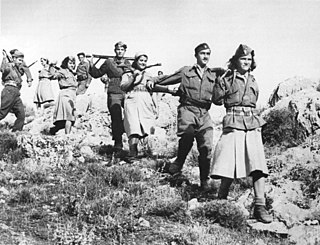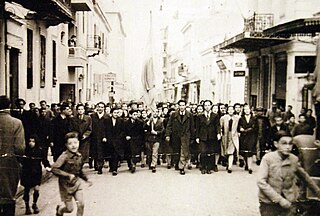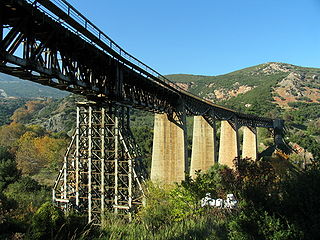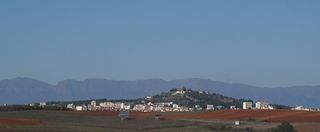Operation Barclay was a World War II deception by the Allies in support of Operation Husky, the Allied invasion of Sicily in July 1943.

The Greek People's Liberation Army was the military arm of the left-wing National Liberation Front (EAM) during the period of the Greek resistance until February 1945, when, following the Dekemvriana clashes and the Varkiza Agreement, it was disarmed and disbanded. ELAS was the largest and most significant of the military organizations of the Greek resistance.

The Greek resistance, involved armed and unarmed groups from across the political spectrum that resisted the Axis occupation of Greece in the period 1941–1944, during World War II. The largest group was the Communist-dominated EAM-ELAS. The Greek Resistance is considered one of the strongest resistance movements in Nazi-occupied Europe, with partisans, men and women known as andartes and andartisses, controlling much of the countryside prior to the German withdrawal from Greece in late 1944.
National and Social Liberation was a Greek Resistance movement during the Axis occupation of Greece. It was founded in autumn 1942 by Colonel Dimitrios Psarros and politician Georgios Kartalis.

The military history of Greece during World War II began on 28 October 1940, when the Italian Army invaded Greece from Albania, beginning the Greco-Italian War. The Greek Army temporarily halted the invasion and pushed the Italians back into Albania. The Greek successes forced Nazi Germany to intervene. The Germans invaded Greece and Yugoslavia on 6 April 1941, and overran both countries within a month, despite British aid to Greece in the form of an expeditionary corps. The conquest of Greece was completed in May with the capture of Crete from the air, although the Fallschirmjäger suffered such extensive casualties in this operation that the Oberkommando der Wehrmacht abandoned large-scale airborne operations for the remainder of the war. The German diversion of resources in the Balkans is also considered by some historians to have delayed the launch of the invasion of the Soviet Union by a critical month, which proved disastrous when the German Army failed to take Moscow.

The occupation of Greece by the Axis Powers began in April 1941 after Nazi Germany invaded the Kingdom of Greece to assist its ally, Italy, in their ongoing war that had started in October 1940. Following the conquest of Crete, the entirety of Greece was occupied starting in June 1941. The occupation of the mainland lasted until Germany and its ally Bulgaria withdrew under Allied pressure in early October 1944, with Crete and some other Aegean islands being surrendered to the Allies by German garrisons in May and June 1945, after the end of World War II in Europe.

Napoleon Zervas was a Hellenic Army officer and resistance leader during World War II. He organized and led the National Republican Greek League (EDES), the second most significant, in terms of size and activity, resistance organization against the Axis Occupation of Greece.
The 4th "Ali Demi" Battalion was a battalion under the 15th Regiment of Greek People's Liberation Army, founded during the Second World War. It comprised both from Cham Albanians and Greeks, of the region of Epirus and was established in May 1944.

Operation Harling, also known as the Battle of Gorgopotamos in Greece, was a World War II mission by the British Special Operations Executive (SOE), in cooperation with the Greek Resistance groups EDES and ELAS, which destroyed the heavily guarded Gorgopotamos viaduct in Central Greece on 25 November 1942. This was one of the first major sabotage acts in Axis-occupied Europe, and the beginning of a permanent British involvement with the Greek Resistance.

The Greek Civil War took place from 1946 to 1949. The conflict, which erupted shortly after the end of World War II, consisted of a communist-dominated uprising against the established government of the Kingdom of Greece. The opposition declared a people's republic, the Provisional Democratic Government of Greece, which was governed by the Communist Party of Greece (KKE) and its military branch, the Democratic Army of Greece (DSE). The rebels were supported by Yugoslavia and the Soviet Union. With the support of the United Kingdom and United States, the Greek government forces ultimately prevailed.
The National Bands Agreement was an agreement concluded on 5 July 1943 at the village of Liaskovo, between the British military mission to occupied Greece and the three main Greek Resistance organizations, EAM-ELAS, EDES and EKKA. Its aim was to coordinate the actions of the Resistance movement in Greece, including the establishment of a joint headquarters under the aegis of the British GHQ Middle East.
The Feneos Executions is the name given to a series of killings committed by the Greek People's Liberation Army (ELAS) resistance group, and especially by its secret police OPLA, in the Feneos area of Corinthia, Greece, during the first stages of the Greek Civil War, while the country was still occupied by the Axis Powers.
The Panhellenic Liberation Organization, was a Greek resistance organization against the Axis occupation of Greece. It was founded in 1941 by a group of Greek army officers, under the name Defenders of Northern Greece, employing methods of non violent resistance. In 1943, YVE was renamed as the Panhellenic Liberation Organization (PAO), shifting its focus towards armed struggle. In the August of the same year it came into conflict with Greek People's Liberation Army (ELAS), a communist-led resistance organization. PAO was defeated in the ensuing civil war and its remnants turned towards collaboration with the Germans.

The Chortiatis Massacre was a violent reprisal by the Greek collaborationist Security Battalions and German army troops during the Axis Occupation of Greece. On 2 September 1944, a platoon of Greek People's Liberation Army (ELAS) fighters ambushed a government water supply column outside Chortiatis village. Several hours later an Axis penal expedition into the area led to the destruction of the village and the parallel execution of 146 of its citizens, most of whom were women and children.

The Battle of Kilkis was an armed conflict between communist resistance organisation ELAS and a coalition of collaborationist Security Battalions, nationalist resistance organisations EDES and the National Greek Army (EES). On 4 November 1944, ELAS captured Kilkis after nine hours of fighting. The nationalists suffered many casualties during the battle and in prisoner killings afterwards.
The Battle of Meligalas took place at Meligalas in Messenia in southwestern Greece, on 13–15 September 1944, between the Greek Resistance forces of the Greek People's Liberation Army (ELAS) and the collaborationist Security Battalions.
Red Terror is a term used by some historians to describe incidents of violence against civilians, by EAM from approximately 1942 or 1943 until the end of the Greek Civil War in 1949. In the countryside, operations were conducted by the ELAS; in cities, by the Organization for the Protection of the People's Struggle (OPLA).
The Battle of Sarantaporos on 21 June 1943 was a successful ambush by the guerrillas of the Greek People's Liberation Army (ELAS) against a column of the German 117th Jäger Division. The ambush, carried out as part of Operation Animals, was one of the most successful operations against the Germans during the Axis occupation of Greece.
Antonis Fosteridis, also known by the nom de guerre of Çauş Anton, was a Pontus-born Greek nationalist, anticommunist partisan during the Axis occupation of Greece, who served in the Hellenic Army during the Greek Civil War and, during peace time, was elected member of the Hellenic Parliament.








